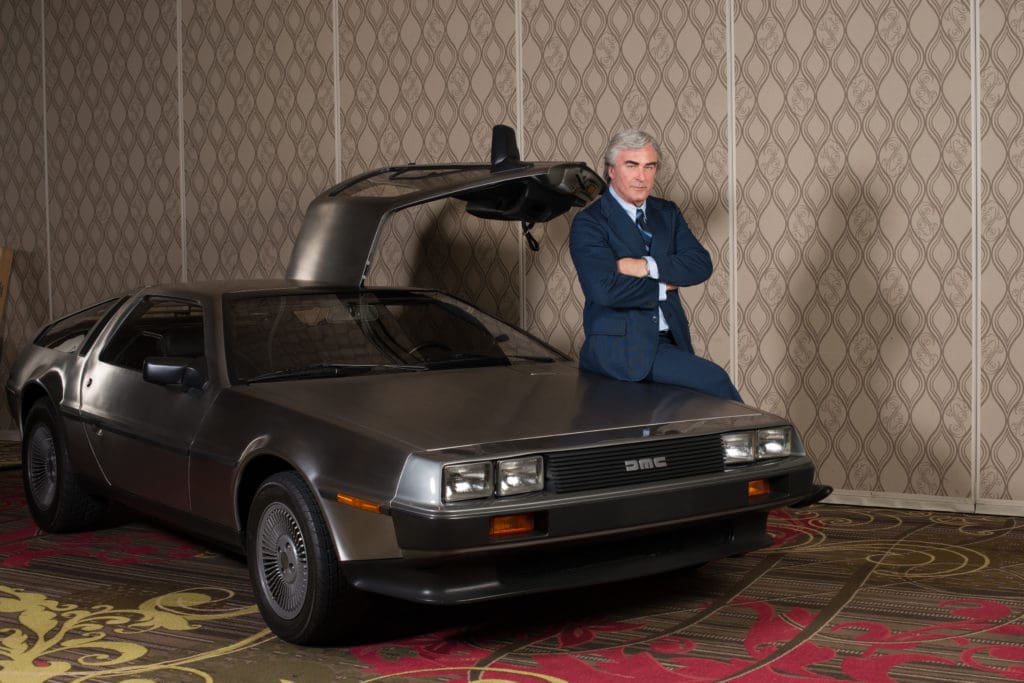
Thanks to 1985’s Back to the Future, just about everyone knows what a DeLorean looks like. However, while the car’s stainless steal frame and winged doors are iconic, many probably aren’t familiar with its maker (no, not Doc. Brown), John DeLorean. Even less are probably aware that part of the reason the car is so rare is that DeLorean was once indicted for his involvement in a drug deal involving 200 kilos of cocaine. It’s a fascinating story, but the new documentary Framing John DeLorean, which premiered at Tribeca tonight, totally bungles the delivery.
Many have tried to make a film about DeLorean — something directors Sheena M. Joyce and Don Argott make clear early on. As one interview subject after another appears onscreen, they’re marked as someone who tried to make a different unproduced DeLorean film, so that by the time they’re 6 or so people in, they actually mark one of the interviewees as “yet another” person who tried to adapt DeLorean’s life. Those unproduced films represent a mix of narrative and documentary and while Framing is technically a documentary, it’s really a mix of both genres.
While archival footage takes up a chunk of the film’s nearly two-hour runtime, a significant portion is made up of re-enactments, or at least, the behind the scenes footage of those re-enactments. While actors like Josh Charles as engineer, Bill Collins, or Morena Baccarin as DeLorean’s 3rd wife, model and eventual morning talk show host, Cristina Ferrare, do solid work, it’s Alec Baldwin as DeLorean who’s the biggest draw.
As Baldwin himself relates late in the film, he was once supposed to play DeLorean in one of the many unproduced adaptations (something DeLorean himself called and asked him to do) and he seems obsessed with getting the character right. We first see him being fitted for a prosthetic chin to match DeLorean’s plastic surgery-enhanced jaw. Perhaps because of that scene–where we watch Baldwin call his wife to get her reaction–and because the make-up isn’t actually that good, Baldwin never disappears into the role. Granted, that’s also because Joyce and Argott never let us forget we’re watching Baldwin play him.
While Framing is supposed to be about John DeLorean’s life, the film frequently foregrounds re-enactments over archival footage. We see Baldwin as DeLorean tell Baccarin as Ferrare that they’ll produce his signature stainless steel car in whatever country gives him the best deal. That’s all the justification the film gives for his decision to build his factory in Belfast—then in some of the worst years of The Troubles between Catholics and Protestants.
All we hear from DeLorean in an old interview is that Belfast is a, “terrible, dangerous place to be.” And yet the factory workers interviewed never address that claim, instead using their screentime to talk about what a great place the factory was to work in its two-plus years in operation. Elsewhere, Joyce and Argott aren’t interested in the meaning of the re-enactments as much as they are watching the actors perfectly lip sync to the audio or matching their movements to the movements of the real-life parties in the archival footage.
Though Baldwin spends much of his screentime in DeLorean garb talking about getting inside the mind of the man who basically helped invent the American muscle car with the Pontiac GTO, the film itself doesn’t seem to care. “He’s a hero in his own mind,” Baldwin says at one point, yet the footage of DeLorean and the current-day interviews with those who know him spend more time telling us what he did than why. We get nothing from present-day Ferrare–who’s still alive–but we do hear from her and DeLorean’s biological daughter, Kathryn, and their adopted son, Zach. Unfortunately, we don’t learn enough about how they felt about their father then or now. We never learn why Zach seems so resentful of his mother–and to a lesser degree–his father, and we never learn why Kathryn is so sympathetic to both. We never learn why he seems to be living in near poverty and why she doesn’t. Instead, the film uses them as mere ornaments, using their memories to paint their father as villain and hero at turns without ever explaining either perspective.
In the end, the problem with Framing John DeLorean isn’t the story, but the way it tells it. Joyce and Argott assume their audience already knows what happened, so they tried to find a sexy, unexpected way to tell it. Unfortunately, their techniques are ultimately self-defeating. By focusing on Baldwin self-directing or mythologizing about DeLorean’s stage of mind, they fail to coherently tell DeLorean’s story or worse, provide any real insight into what drove him or how he felt when it fell apart. The directors may allow Zach to express his fear that a Hollywood adaptation of his father’s life would end before it told the whole story, but what happens even here may be even worse.


Hello Marisa: Would you be interested in reviewing a book that tells the Drug Side of the DeLorean Case? I am the sole surviving defendant. John Z. DeLorean and I merged our defenses. I was the pilot in the case. My book “In DeLorean’s Shadow,” has won awards and it tells the gritty side, but know it is my story, less about DeLorean and more about Pablo Escobar’s Medellin Cartel, and all the bad guys. To prove what I wrote, I have DeLorean’s investigative files, which I received from JZD when we merged our defenses and the super secret FBI investigative reports and taped telephone conversations and FBI wires. I know things that were never revealed. Such as Morgan Hetrick knew Christina before John DeLorean and no one ever picked up on that.